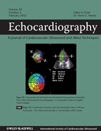Beta Adrenergic Receptor Blockade Causing Severe Left Ventricular Systolic Dysfunction during Dobutamine Stress Echocardiography in a Patient with No Structural Heart Disease
Abstract
A 41-year-old woman with a history of neurocardiogenic syncope treated with beta-blockers was admitted with chest pain. Dobutamine echocardiogram images demonstrated decreased global LV systolic wall motion and thickening. Coronary angiograms were normal. Beta-blockers were stopped and dobutamine stress echocardiogram (DSE) was repeated. Dobutamine images demonstrated increased global LV systolic wall motion and thickening. Beta-blockers were restarted and again dobutamine produced global LV dysfunction. This case suggests that DSE wall motion response may be falsely abnormal in a patient on beta-blockers. Physicians should be aware of this possibility when interpreting dobutamine echocardiography in patients taking beta-blockers. (Echocardiography 2012;29:E39-E42)




